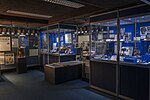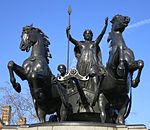Norman Shaw Buildings
Buildings and structures in the City of WestminsterBuildings and structures on the River ThamesFormer Metropolitan Police stationsGrade II* listed buildings in the City of WestminsterGrade II* listed government buildings ... and 6 more
Grade I listed buildings in the City of WestminsterGrade I listed government buildingsNational government buildings in LondonOffice buildings completed in 1906Parliamentary EstateRichard Norman Shaw buildings

The Norman Shaw Buildings (formerly known as New Scotland Yard) are a pair of buildings in Westminster, London, overlooking the River Thames. The buildings were designed by the architects Richard Norman Shaw and John Dixon Butler, between 1887 and 1906, they were originally the location of New Scotland Yard (the headquarters of the Metropolitan Police) between 1890 and 1967, but from 1979, have been used as parliamentary offices and have been named Norman Shaw North and South Buildings, augmenting limited space in the Palace of Westminster.
Excerpt from the Wikipedia article Norman Shaw Buildings (License: CC BY-SA 3.0, Authors, Images).Norman Shaw Buildings
Commissioner's Yard, City of Westminster Lambeth
Geographical coordinates (GPS) Address Nearby Places Show on map
Geographical coordinates (GPS)
| Latitude | Longitude |
|---|---|
| N 51.502 ° | E -0.1246 ° |
Address
Westminster
Commissioner's Yard
SW1A 2HZ City of Westminster, Lambeth
England, United Kingdom
Open on Google Maps










